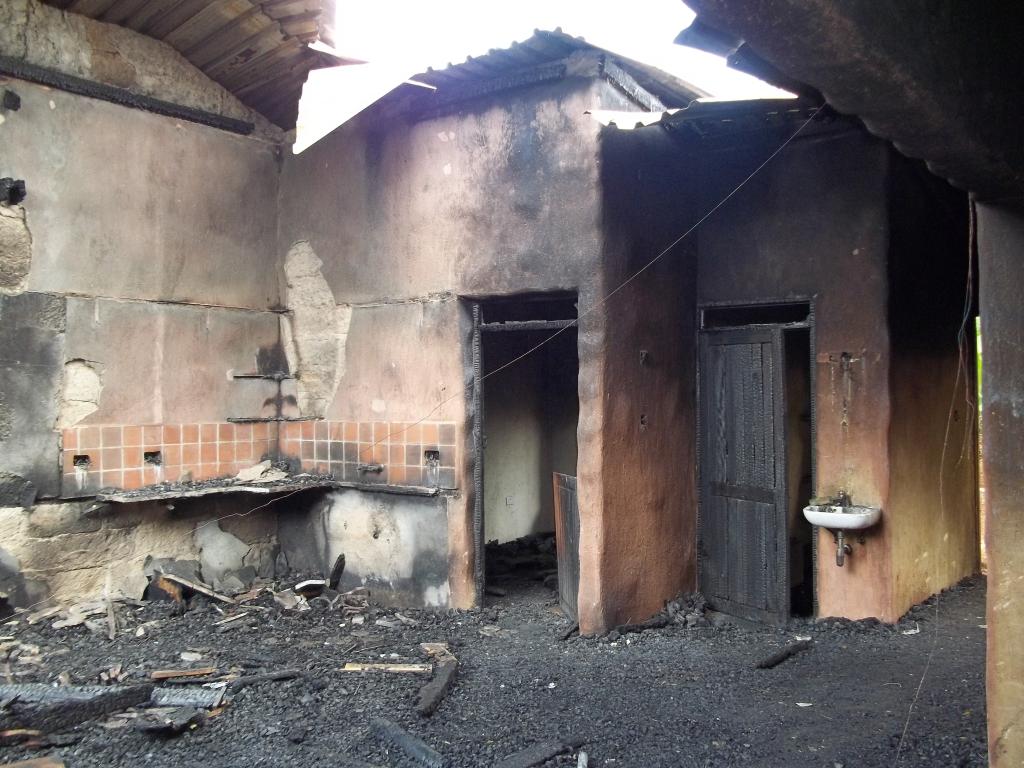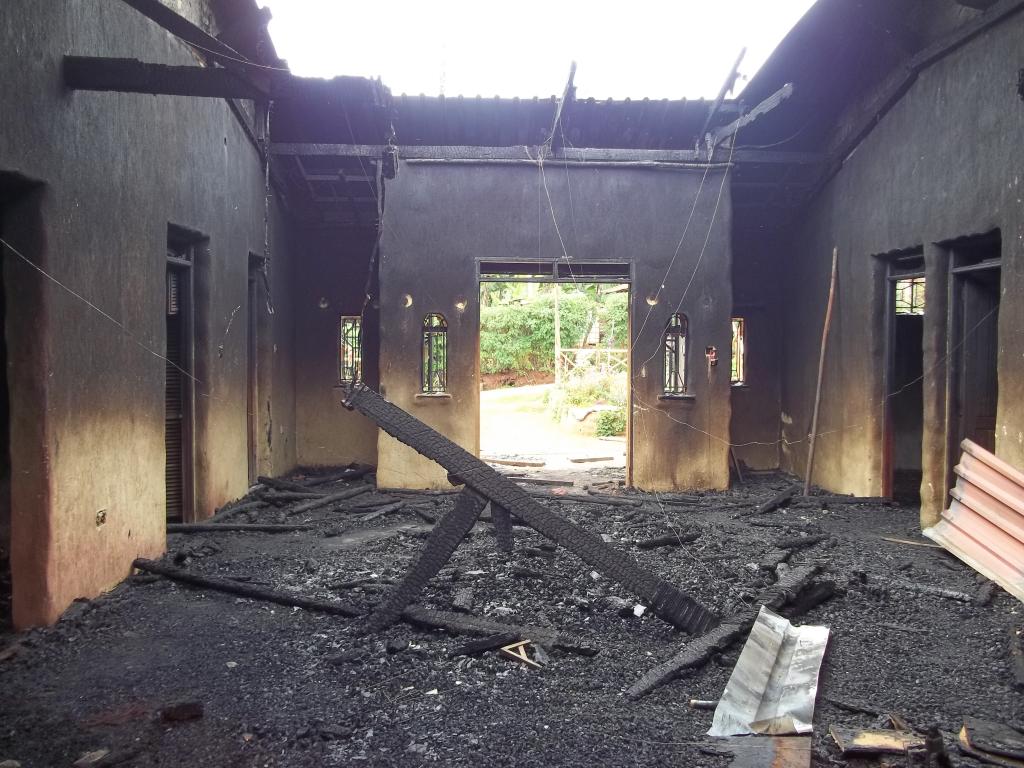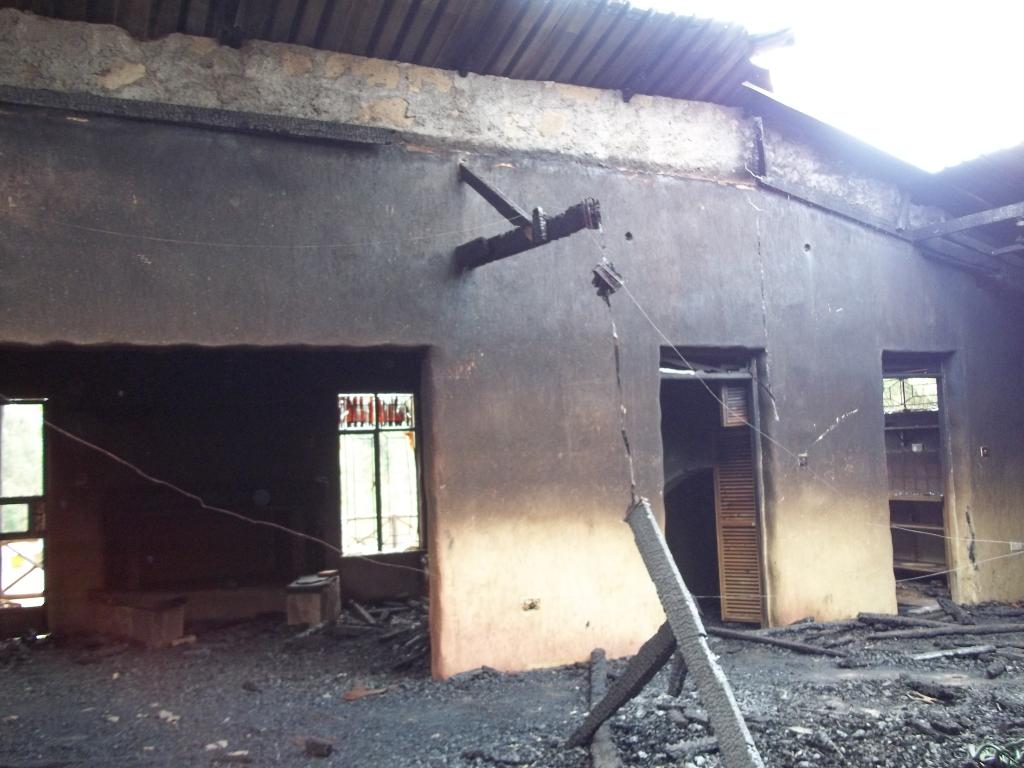Chrissie has managed to send these photos through using some else’s computer as her laptop was destroyed in the fire.
They’re heart-breaking to look at.








For Peacemakers International 2012 has been a year with highs and lows, intermingled with blessings. The biggest blessing of all has been the Faithfulness of God in keeping true to His promise and vision and giving us strength to overcome all the different circumstances that presented themselves to us throughout the year.
I have put bulletins and photographs on our web page, keeping you informed of the progress of our Resource Centre and some of the events that have taken place throughout the year. There have been visitors from the UK staying on site, giving of their skills and enjoying the beautiful gardens and facilities that have been developed and established on barren ground. We were almost at the stage of completion of the Kisimani House and insuring the whole complex so that we could advertise and hire out the multi purpose buildings and resources; when the double shock came in August that Isaac had suddenly died and a few days later (the day of his funeral) Kisimani house was burnt down.
We were all devastated by this, I personally felt that all the stuffing had been knocked out of me, and struggled to stand in faith for a while. But hearing reports from Christine in Kenya about how the local Kenyans had rallied round and responded immediately to try to put the fire out and salvage as much as possible from the debris, it began to bring a realisation that the Kenyans, at last, were beginning to take up their responsibility in this vision. I’m happy to report that the Kenyans are now involved and planning fund raising events to try and restore Kisimani house, realising its God’s provision for them to use, to care and support the needy in their community and to become self-sufficient.
I have mentioned God’s vision many times before, so I think it necessary at this stage to explain the purpose of building a Resource Centre. As this is quite detailed, please the article previous to this one and read it at your leisure.
When you read the document, much of that spoken about is already in place and buildings that are completed are being hired -out and used. The Centre is unique and is like an oasis in the middle of a disturbed and needy community; and is the first of its kind. There needs to be a Resource Centre like this in every district, and we hope from this pilot example, Kenyans will spread this vision across their tribal districts. God’s vision is for a project like this to be in every African country.
So be encouraged all our Peacemakers’ friends and sponsors, for what you have helped to build, and thank you for your faithfulness in helping to fulfil the promise of God to the Kenyans, despite one or two set backs this year. Already we can see good coming out of the debris.
The Peacemakers’ Team and I, wish to express our heart-felt thanks and appreciation for your constant support and generosity.
Brenda Marshall
Director of Peacemakers International
The following is taken from a funding request to Safaricom Kenya, trying to obtain assistance in rebuilding the Kisimani house after the fire:
Peacemakers Community Resource Centre, Kenya
Vision of Peacemakers:
Peacemakers Kenya is a registered charity based organization (CBO) who have been working near Embu, Kenya, in collaboration with UK well- wishers, for 21 years. Its main mission is to bring people together to become more effective in networking, learning, training and giving mutual support for positive, dynamic community development. It seeks to alleviate the effects of poverty and other social challenges like addictions, disability, gender strife and community harmony. It seeks to support vulnerable individuals and groups to transform their lives and to become sustainable through motivational, entrepreneurial activities. In the past, it has initiated projects and micro-enterprises, trained hundreds in Primary Health, HIV AIDS, Drugs awareness, Physical Education and First Aid. It has donated cows to over 80 schools, thousands of mosquito nets to communities and school effects to link institutions. Since 2008, it has slowly been building a small age-friendly Resource Centre near Runyenje’s in order to fulfill its aim of having a base for a variety of purposes:
Project objectives
The resource centre is so well used by groups for meetings, education, motivation , celebrations, faith gathering and a myriad of other reasons. It promotes harmony and social networking. It gives access for less privileged members of the community to gain information and skills to improve their living standards. It is well used by youth for study, entertainment and cultural development. It is used for the disabled groups for meetings and mutual support. It is used by administrative officials, politicians and NGOs working with community groups. It is used by teachers and students for day retreats.
It is used by addicts for counselling and support. Rehabilitating youths and older addicts run a tree nursery and help in the garden produce shamba which is sold locally. They keep rabbits and chickens also.
The place will be for public use and any profits, after expenses will go into supporting community projects that help vulnerable groups and individuals, selected by a community committee. These will be sustainable activities rather than hand-outs, except in extreme cases.
The land and buildings are owned by Peacemakers but the trustees and community representatives are the custodians on behalf of the people and maintain its operational costs and development.
The current and future activities depend on the community centre being well used leading to sustainability and eventual profit. No monies will be deployed to other uses other than those that concur with our overall mission of supporting the vulnerable and facilitating dynamic community development.